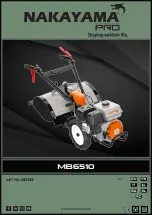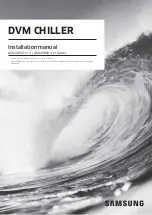
75
9. Finned surfaces should remain wet with cleaning solution
for 10 minutes.
10. Ensure surfaces are not allowed to dry before rinsing. Reap-
ply cleaner as needed to ensure 10-minute saturation is
achieved.
11. Thoroughly rinse all surfaces with low velocity clean water
using downward rinsing motion of water spray nozzle. Pro-
tect fins from damage from the spray nozzle.
Condenser Fans
A formed metal mount bolted to the coil caps supports each fan
and motor assembly. A shroud and a wire grille provide protection
from the rotating fan. See Fig. 72. To remove the fan a special
puller (RCD part no. 30RB680082) can be used. The fan utilizes a
set screw and does not require the use of retaining compound in
the keyway. The fan can be removed without the puller, but its use
eases disassembly. The exposed end of the fan motor shaft is pro-
tected from weather by grease. If fan motor must be removed for
service or replacement, re-grease the fan shaft. The fan needs to be
positioned fully down against the step on the motor shaft. Apply
blue thread locker (Loctite 243) to the threads of both the axial
bolt and the set screw. Install the thick washer and M8 axial bolt;
do not fully tighten. Install set screw and tighten to 16 ± 2 ft-lbs
(21.7 ± 2.7 Nm). Torque the axial bolt to 24 ± 2 ft-lbs (32.5 ± 2.7
Nm). Reinstall shroud and wire grille.
High Static Fan Option
A different fan blade is used for the high static fan option. It
does not have the set screw to retain the key, so retaining com-
pound must be used. The same puller is required to remove this
fan blade. Use Loctite 603 retaining compound on the shaft
and keyway during re-assembly. Remove any grease or con-
taminates from the fan motor shaft before installation.
Refrigerant Circuit
LEAK TESTING
Units are shipped with complete operating charge of refriger-
ant R-134a (see Physical Data tables supplied in the 30XV in-
stallation instructions) and should be under sufficient pressure
to conduct a leak test. If there is no pressure in the system, in-
troduce enough nitrogen to search for the leak. Repair the leak
using good refrigeration practices. After leaks are repaired,
system must be evacuated and dehydrated.
REFRIGERANT CHARGE
Refer to Physical Data tables supplied in the 30XV installation in-
structions. Immediately ahead of filter drier in each circuit is a fac-
tory-installed liquid line service valve. Each valve has a
1
/
4
-in. ac-
cess connection for charging liquid refrigerant.
Charging with Unit Off and Evacuated
Close liquid line service valve before charging. Weigh in charge
shown on unit nameplate. Open liquid line service valve; start unit
and allow it to run several minutes fully loaded. Check for a clear
sight glass. Be sure clear condition is liquid and not vapor.
Charging with Unit Running
If charge is to be added while unit is operating, all condenser
fans and compressors must be operating. It may be necessary
to block condenser coils at low ambient temperatures to raise
condensing pressure to approximately 198 psig (1365 kPa) to
turn all condenser fans on. Do not totally block a coil to do this.
Partially block all coils in uniform pattern. Charge each circuit
until sight glass shows clear liquid, and has a liquid line tem-
perature of 103°F (39°C).
Add 3 to 5 lb (1.36 to 2.27 kg), depending on unit size and coil
type, of liquid charge into the fitting located on the tube enter-
ing the evaporator. This fitting is located between the electron-
ic EXV and the evaporator.
Allow the system to stabilize and then recheck the liquid tem-
perature. If needed, add additional liquid charge, 3 to 5 lb at a
time, allowing the system to stabilize between each charge ad-
dition. Slowly add charge as the sight glass begins to clear to
avoid overcharging.
Safety Devices
The 30XV chillers contain many safety devices and protection
logic built into the electronic control. Following is a descrip-
tion of the major safeties.
COMPRESSOR PROTECTION
Motor Overload
The compressor VFD fuses and drive logic protect each com-
pressor against overcurrent.
All compressors have factory-installed high-pressure switches.
See Table 46. Each high-pressure switch is connected directly
to its associated VFD (terminals 12 and 37). If the switch
opens during operation, the compressor will be shut down.
Manual reset of the high pressure switch, VFD, and the control
is required to restart the compressor.
Table 46 — High-Pressure Switch Settings
Fig. 72 — Fan Mounting
IMPORTANT: When adjusting refrigerant charge, circulate
fluid through evaporator continuously to prevent freezing and
possible damage to the evaporator. Do not overcharge, and
never charge liquid into the low-pressure side of system.
UNIT
SWITCH SETTING
psig
kPa
30XV
323.5 + 0.0 –14.0
2230 + 0.0 –14.0
WIRE GUARD
FAN BLADE
FAN DECK
FORMED METAL
MOUNT
MOTOR
a30-5863
Summary of Contents for AquaForce 30XV140
Page 79: ...79 Fig 76 VFD Communication Wiring Compressor A B Fan VFD A1 A2 B1 B2...
Page 228: ...228 Fig 90 30XV Typical Field Wiring Schematic cont...
Page 229: ...229 Fig 91 30XV Standard Tier 140 275 All Voltages Power Schematic NOTE See Legend on page 226...
Page 230: ...230 Fig 92 30XV Standard Tier 300 325 All Voltages Power Schematic NOTE See Legend on page 226...
Page 240: ...240 Fig 99 30XV Communication Wiring...
Page 241: ...241 Fig 100 30XV 115V Control Wiring All Tonnages All Voltages...
Page 242: ...242 Fig 101 30XV 24V Control Wiring 30XV140 325 All Voltages...
Page 243: ...243 Fig 101 30XV 24V Control Wiring 30XV140 325 All Voltages cont...
Page 244: ...244 Fig 102 30XV 24V Control Wiring 30XV350 500 All Voltages...
Page 245: ...245 Fig 102 30XV 24V Control Wiring 30XV350 500 All Voltages cont...
Page 246: ...246 Fig 103 Component Arrangement Diagram for 30XV140 325...
Page 247: ...247 Fig 103 Component Arrangement Diagram for 30XV140 325 cont...
Page 248: ...248 Fig 104 Component Arrangement Diagram for 30XV350 500...
Page 337: ...337 APPENDIX J FACTORY SUPPLIED PUMPS cont Fig L System Information...
Page 338: ...338 APPENDIX J FACTORY SUPPLIED PUMPS cont Fig M Unit and Language Settings...
Page 341: ...341 APPENDIX J FACTORY SUPPLIED PUMPS cont Fig P Data Input 2...
Page 342: ...342 APPENDIX J FACTORY SUPPLIED PUMPS cont Fig Q Data Input 3...
Page 347: ...347 APPENDIX J FACTORY SUPPLIED PUMPS cont Fig U Pump Wiring Diagram...
















































